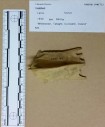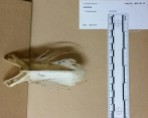Last week I gave you this mystery object to have a go at identifying:

I expected most of the regulars to recognise that it’s a bird sternum, since I’ve talked about them quite a lot in the past – to the point of putting together images of a range of sterna from different bird families to help narrow down identifications:
However, this mystery sternum didn’t appear in my gallery, so I thought it would offer a bit of a challenge. Of course, that was before Wouter van Gestel (creator of the fantastic Skullsite resource) recognised it as being from a bird with a fascinating reproductive method based around carefully planned neglect. Yep, this is the sternum of a Common Cuckoo Cuculus canorus Linnaeus, 1758.
Cuckoos are visitors to Britain and Ireland, where they spend their summer holidays destroying the families of host birds (like Dunnocks and Reed Warblers) by removing an egg from the nests of a smaller species and laying their own egg. If the switch isn’t noticed (and most of the time it isn’t) the egg hatches and the Cuckoo chick turfs out the remaining eggs of the host birds, then demands vast quantities of food from the unwitting foster parents.
To help pull off this remarkable feat of irresponsible parenting (or brood parasitism as it’s more properly known), Cuckoos have become remarkable mimics. The male is similar in pattern, colour and flight style to a Eurasian Sparrowhawk – a notable predator of small songbirds.
He hangs around, scaring the host birds off their nest or acting as a distraction, so the female can sneak in and drop off an egg, which itself mimics the colouration of the host bird’s eggs. Different Cuckoos have different species of host bird that they specialise in parasitising, so their eggs are adapted to colour match those host eggs – which is important, since several host species have become wise to the Cuckoo’s tricks and will abandon or destroy any egg they recognise as different.
Bizarrely, after all this careful disguise and the danger of discovery, the Cuckoo chick that ends up being fed copious amounts of food by the foster parents rapidly becomes a behemoth that could by no means pass as the same species as its hosts, yet the foster parents carry on feeding it.
It’s remarkable to consider that the complex behaviours of Cuckoos must be entirely genetically determined, since they never meet their parents and never get to learn how to Cuckoo from another member of their own species.
With this as the mystery object, I was delighted last weekend when I heard my first Cuckoo of the year in County Clare – and I was even more excited when I saw one in flight. They may be sneaky destroyers of families, but they are also the heralds of summer in the countryside and it’s hard to not have a soft spot for their evocative call.






















Lovely stuff as always, Paolo. Ta.
Here in Bombay, and through much of India, the commonest cuckoo is the koel (Eudynamys scolopaceus) where the male, apart from the bill, is glossy black throughout, but the female is speckled (not seemingly deliberately to mimic a sparrowhawk, though, because if you see the females they are usually hiding just under the canopy of a tree, looking around sneakily as though to gauge whether or not the crows (or whoever their target may be) has left the nest. Their wonderful rising and repeated “kuoo” call is part of the dawn patrol round these parts in what passes for Spring.
Less common, but more spectacular, is the hawk-cuckoo (Hierococcyx varius, also earlier called Cuculus varius) which so closely resembles a sparrowhawk I have seen whole colonies of crows disperse in panic at the mere sight of one perched on a branch. It is not a big bird and, if one looks closely, the head and bill, that are far more like that of a pigeon than a hawk, give the game away, but it took me a while to notice the difference and it clearly fools the crows.
I am lucky to have seen both of these in Bombay, not a city one would think was friendly to birds, but which seems to have a surprising variety of them if one looks.
Fascinating stuff Ravi. The urban environment can be far more welcoming to some species than we might expect!
Indeed. The crows and pigeons thrive here, as do the black kites.
Unfortunately it is a diversity bottleneck, of sorts – the successful species/commensals seem to thrive ever more while the slightly less successful ones are pushed out.
The hourse sparrow here, just as in the UK, is disappearing. I can still see one or two in various places, but they don’t teem in their thousands the way they used to.
And the great Bengal vulture, spiralling on the thermals even aboove the black kites, but never mistaken for them thanks to their fan-shaped tails and forward sweeping wings, is effectively extinct. Admittedly it was the indiscriminate use of diclofenac that did for them, but just 20 or 30 years ago, when I first lived here, they could fill the sky in parts. In that same time I saw so many birds that you no longer see in this city: golden orioles, hoopoes (yes!), Brahminy kites (I have seen only two in four years now, and one was injured and in a kite sanctuary), and many more.*
I am grateful for those, though uncommon, that still occasionally come round: the speckled fantail warblers, the red-vented bulbuls and the red-cheeked ones, the common mynas, and more.
But I fear that they too, in time, will get squeezed out, with just one “specialist” per niche.
Ah well, best to enjoy them while I can, I guess.
*What surprises me is how, despite the huge pigeon population, the higrise buildings, and the prolificity of rodents and shrews, you don’t see genuine hunting specialists – kestrels and peregrine falcons (the Indian version commonly called the shikra). The black kites hunt occasionally, it is true (I was fortunate enough to see one swoop unexpectedly down right in front of me and snatch a shrew off the pavement), but they are far more scavengers than predators. Hmmmm…
excellent again paolo. always learn something new here!
over the winter/xmas holidays we saw several members of the terrestrial cuckoo, the greater road runner. any idea what percentage of cuckoos are nest parasites? road runners are not, and seems it would be harder for a ground dwelling bird.
most of the united states has the brown headed cowbird, an icterid, also a nest parasite. i saw controls on them (trapping and gassing) in michigan to try and protect the kirtland’s warbler.
some studies now seem to indicate removal may actually increase productivity as at lower parasite densities the hosts drop their defenses and abandon their afflicted nests less often.
talk about laws of unintended consequences….
beep beep!
What a great mystery and its resolution. Thanks so much for the comparison sheet on sterna. And for the lesson on Cuckoos, which are not found near me. We do have the Brown Headed Cowbird. Thanks to Joe Band for pointing out that we should interfere with caution. And thanks to Palfreyman for the lesson on the Cuckoos of Bombay. On the California Coast the now de-listed Peregrine Falcon is eating an endangered plover. Guess what we are doing to protect the plover? Yep. Capital punishment. The Feds would not permit falconers to trap the Peregrines. Though a few were legally trapped and released in Oregon. Elsewhere in the state, we are being invaded by the Barred Owl, who is preying on its listed Northern Spotted cousin. In their wisdom, the Wildlife Service folks are killing the Barred Owl, too. Though I believe they are being questioned on the wisdom of this . . . we seem bound and determined to control the lives of other species, and of folks of different ideas.
I am trying to find a good source of information on why the sterna are so different among bird families. Type of flight is the easy part. What about those things like the lateral caudal processes? Any suggestions?
Some of you may not know this bird’s North American relative is sometimes called a “rain crow”: https://www.audubon.org/field-guide/bird/yellow-billed-cuckoo